Logica Case Study: Strategies, Influences, and Decisions
VerifiedAdded on 2022/08/25
|6
|1442
|15
Case Study
AI Summary
This case study analyzes the Logica case, addressing three key questions. Firstly, it examines Logica's strategies to expand its talent pool, including direct training, apprenticeships, degree programs, and a focus on diversity. Secondly, it explores how social influences, such as pressure to meet deadlines or increase sales, have altered employers' attitudes and approaches towards employees, leading to strategies like targeted training. Finally, it evaluates how the external environment, encompassing political, economic, socio-cultural, technological, environmental, and legal factors, influences business decisions, using examples like Apple and Nestle to illustrate the impact of external changes and the importance of analyses like PEST to make informed decisions.
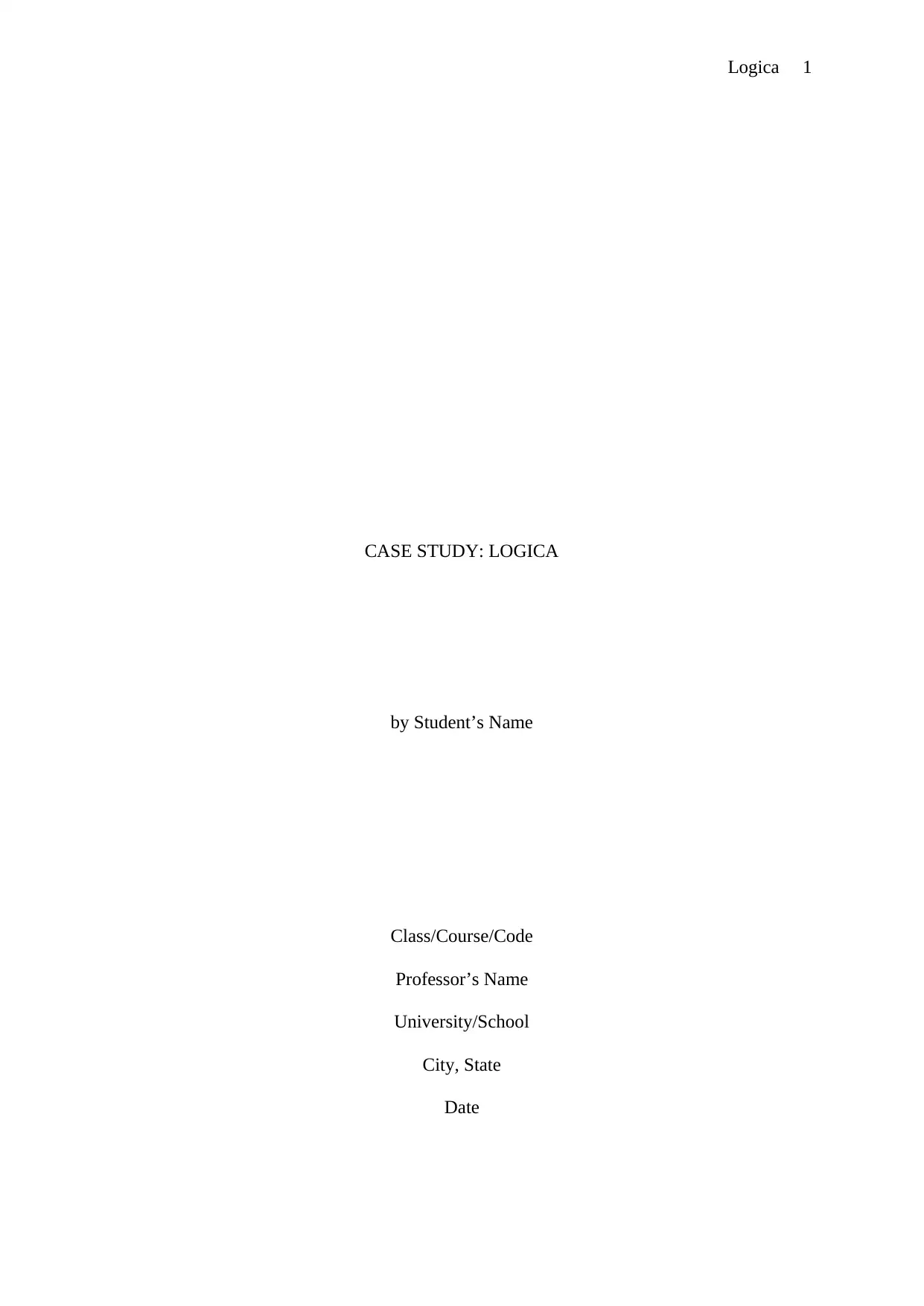
Logica 1
CASE STUDY: LOGICA
by Student’s Name
Class/Course/Code
Professor’s Name
University/School
City, State
Date
CASE STUDY: LOGICA
by Student’s Name
Class/Course/Code
Professor’s Name
University/School
City, State
Date
Paraphrase This Document
Need a fresh take? Get an instant paraphrase of this document with our AI Paraphraser
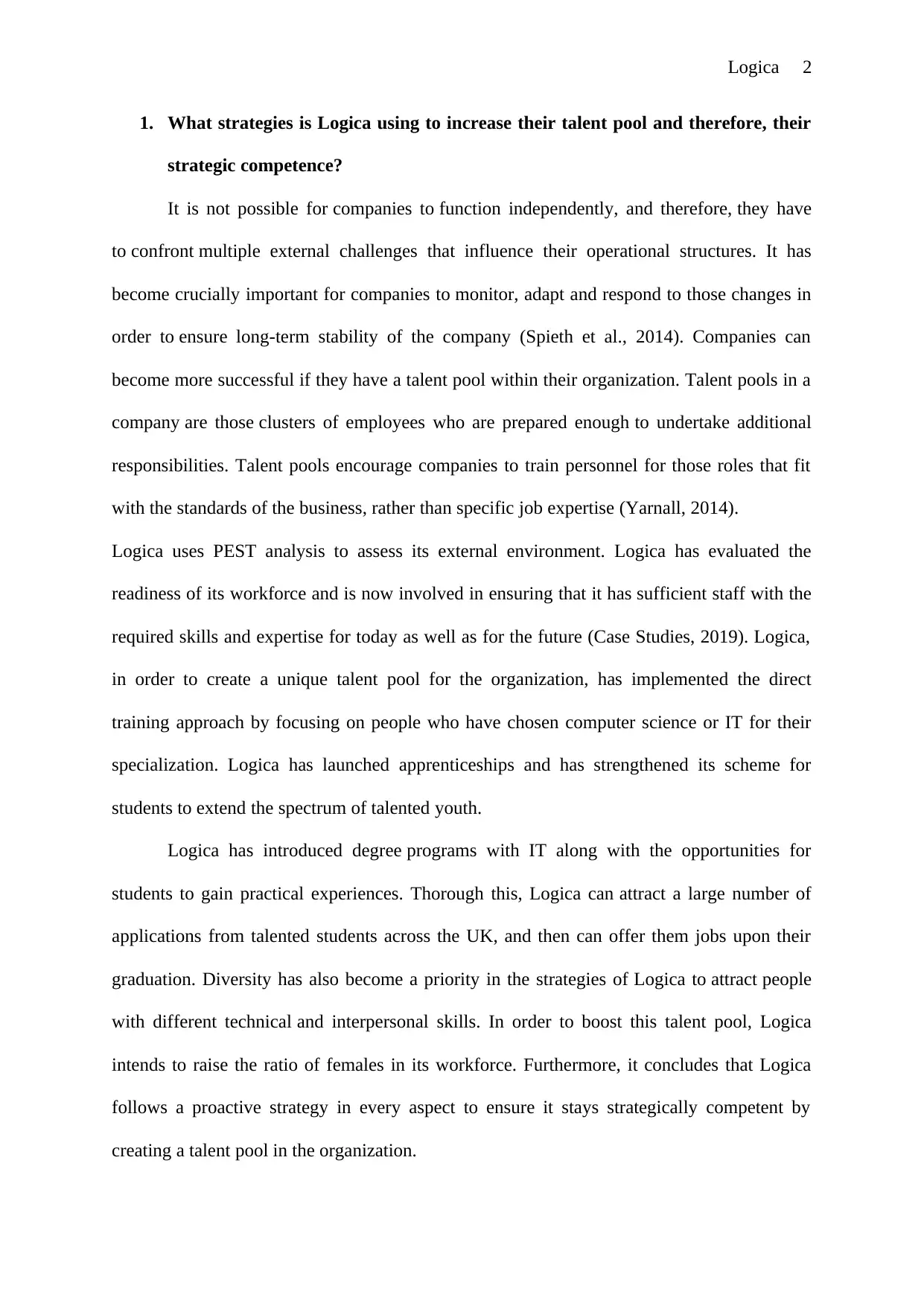
Logica 2
1. What strategies is Logica using to increase their talent pool and therefore, their
strategic competence?
It is not possible for companies to function independently, and therefore, they have
to confront multiple external challenges that influence their operational structures. It has
become crucially important for companies to monitor, adapt and respond to those changes in
order to ensure long-term stability of the company (Spieth et al., 2014). Companies can
become more successful if they have a talent pool within their organization. Talent pools in a
company are those clusters of employees who are prepared enough to undertake additional
responsibilities. Talent pools encourage companies to train personnel for those roles that fit
with the standards of the business, rather than specific job expertise (Yarnall, 2014).
Logica uses PEST analysis to assess its external environment. Logica has evaluated the
readiness of its workforce and is now involved in ensuring that it has sufficient staff with the
required skills and expertise for today as well as for the future (Case Studies, 2019). Logica,
in order to create a unique talent pool for the organization, has implemented the direct
training approach by focusing on people who have chosen computer science or IT for their
specialization. Logica has launched apprenticeships and has strengthened its scheme for
students to extend the spectrum of talented youth.
Logica has introduced degree programs with IT along with the opportunities for
students to gain practical experiences. Thorough this, Logica can attract a large number of
applications from talented students across the UK, and then can offer them jobs upon their
graduation. Diversity has also become a priority in the strategies of Logica to attract people
with different technical and interpersonal skills. In order to boost this talent pool, Logica
intends to raise the ratio of females in its workforce. Furthermore, it concludes that Logica
follows a proactive strategy in every aspect to ensure it stays strategically competent by
creating a talent pool in the organization.
1. What strategies is Logica using to increase their talent pool and therefore, their
strategic competence?
It is not possible for companies to function independently, and therefore, they have
to confront multiple external challenges that influence their operational structures. It has
become crucially important for companies to monitor, adapt and respond to those changes in
order to ensure long-term stability of the company (Spieth et al., 2014). Companies can
become more successful if they have a talent pool within their organization. Talent pools in a
company are those clusters of employees who are prepared enough to undertake additional
responsibilities. Talent pools encourage companies to train personnel for those roles that fit
with the standards of the business, rather than specific job expertise (Yarnall, 2014).
Logica uses PEST analysis to assess its external environment. Logica has evaluated the
readiness of its workforce and is now involved in ensuring that it has sufficient staff with the
required skills and expertise for today as well as for the future (Case Studies, 2019). Logica,
in order to create a unique talent pool for the organization, has implemented the direct
training approach by focusing on people who have chosen computer science or IT for their
specialization. Logica has launched apprenticeships and has strengthened its scheme for
students to extend the spectrum of talented youth.
Logica has introduced degree programs with IT along with the opportunities for
students to gain practical experiences. Thorough this, Logica can attract a large number of
applications from talented students across the UK, and then can offer them jobs upon their
graduation. Diversity has also become a priority in the strategies of Logica to attract people
with different technical and interpersonal skills. In order to boost this talent pool, Logica
intends to raise the ratio of females in its workforce. Furthermore, it concludes that Logica
follows a proactive strategy in every aspect to ensure it stays strategically competent by
creating a talent pool in the organization.
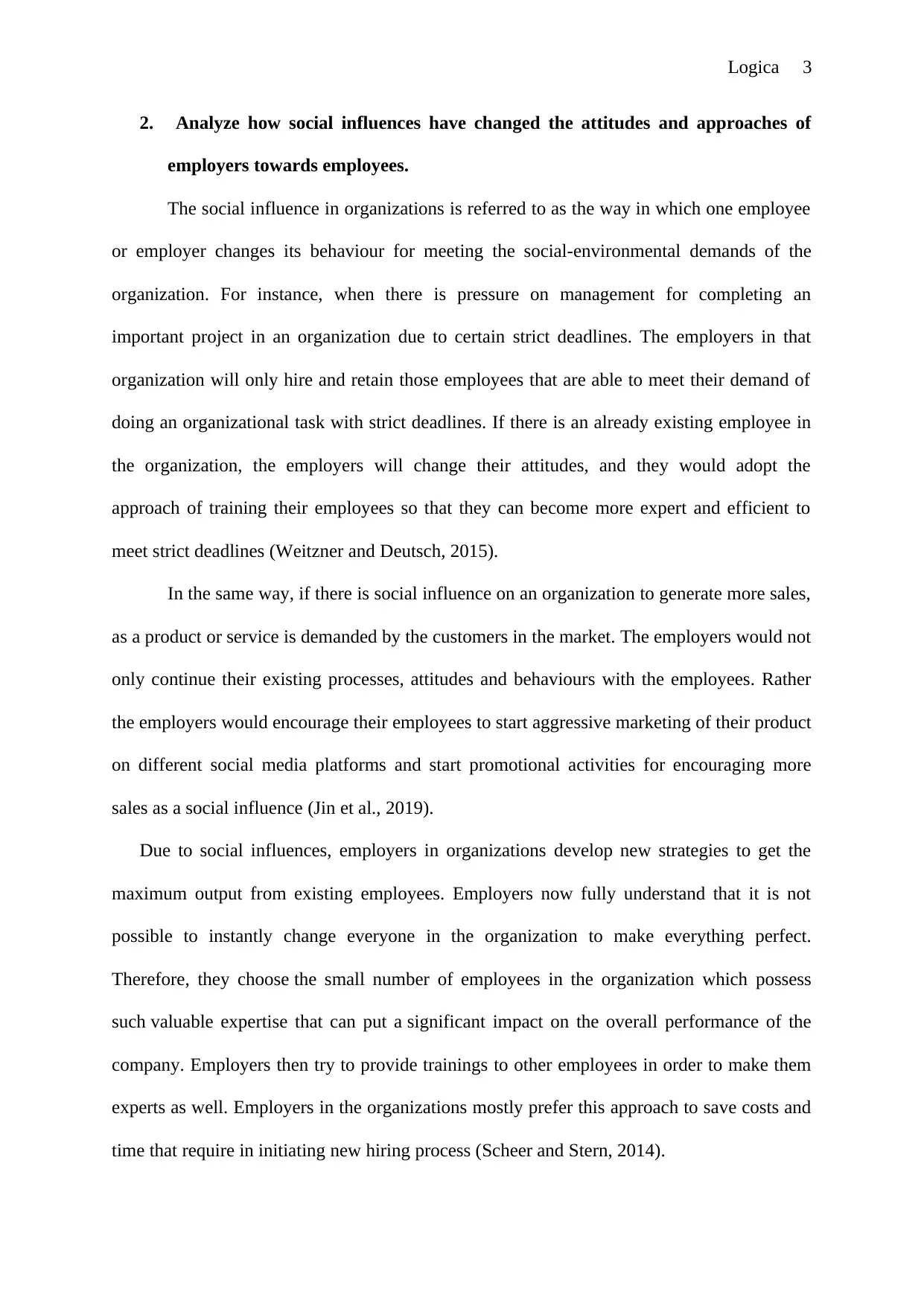
Logica 3
2. Analyze how social influences have changed the attitudes and approaches of
employers towards employees.
The social influence in organizations is referred to as the way in which one employee
or employer changes its behaviour for meeting the social-environmental demands of the
organization. For instance, when there is pressure on management for completing an
important project in an organization due to certain strict deadlines. The employers in that
organization will only hire and retain those employees that are able to meet their demand of
doing an organizational task with strict deadlines. If there is an already existing employee in
the organization, the employers will change their attitudes, and they would adopt the
approach of training their employees so that they can become more expert and efficient to
meet strict deadlines (Weitzner and Deutsch, 2015).
In the same way, if there is social influence on an organization to generate more sales,
as a product or service is demanded by the customers in the market. The employers would not
only continue their existing processes, attitudes and behaviours with the employees. Rather
the employers would encourage their employees to start aggressive marketing of their product
on different social media platforms and start promotional activities for encouraging more
sales as a social influence (Jin et al., 2019).
Due to social influences, employers in organizations develop new strategies to get the
maximum output from existing employees. Employers now fully understand that it is not
possible to instantly change everyone in the organization to make everything perfect.
Therefore, they choose the small number of employees in the organization which possess
such valuable expertise that can put a significant impact on the overall performance of the
company. Employers then try to provide trainings to other employees in order to make them
experts as well. Employers in the organizations mostly prefer this approach to save costs and
time that require in initiating new hiring process (Scheer and Stern, 2014).
2. Analyze how social influences have changed the attitudes and approaches of
employers towards employees.
The social influence in organizations is referred to as the way in which one employee
or employer changes its behaviour for meeting the social-environmental demands of the
organization. For instance, when there is pressure on management for completing an
important project in an organization due to certain strict deadlines. The employers in that
organization will only hire and retain those employees that are able to meet their demand of
doing an organizational task with strict deadlines. If there is an already existing employee in
the organization, the employers will change their attitudes, and they would adopt the
approach of training their employees so that they can become more expert and efficient to
meet strict deadlines (Weitzner and Deutsch, 2015).
In the same way, if there is social influence on an organization to generate more sales,
as a product or service is demanded by the customers in the market. The employers would not
only continue their existing processes, attitudes and behaviours with the employees. Rather
the employers would encourage their employees to start aggressive marketing of their product
on different social media platforms and start promotional activities for encouraging more
sales as a social influence (Jin et al., 2019).
Due to social influences, employers in organizations develop new strategies to get the
maximum output from existing employees. Employers now fully understand that it is not
possible to instantly change everyone in the organization to make everything perfect.
Therefore, they choose the small number of employees in the organization which possess
such valuable expertise that can put a significant impact on the overall performance of the
company. Employers then try to provide trainings to other employees in order to make them
experts as well. Employers in the organizations mostly prefer this approach to save costs and
time that require in initiating new hiring process (Scheer and Stern, 2014).
⊘ This is a preview!⊘
Do you want full access?
Subscribe today to unlock all pages.

Trusted by 1+ million students worldwide
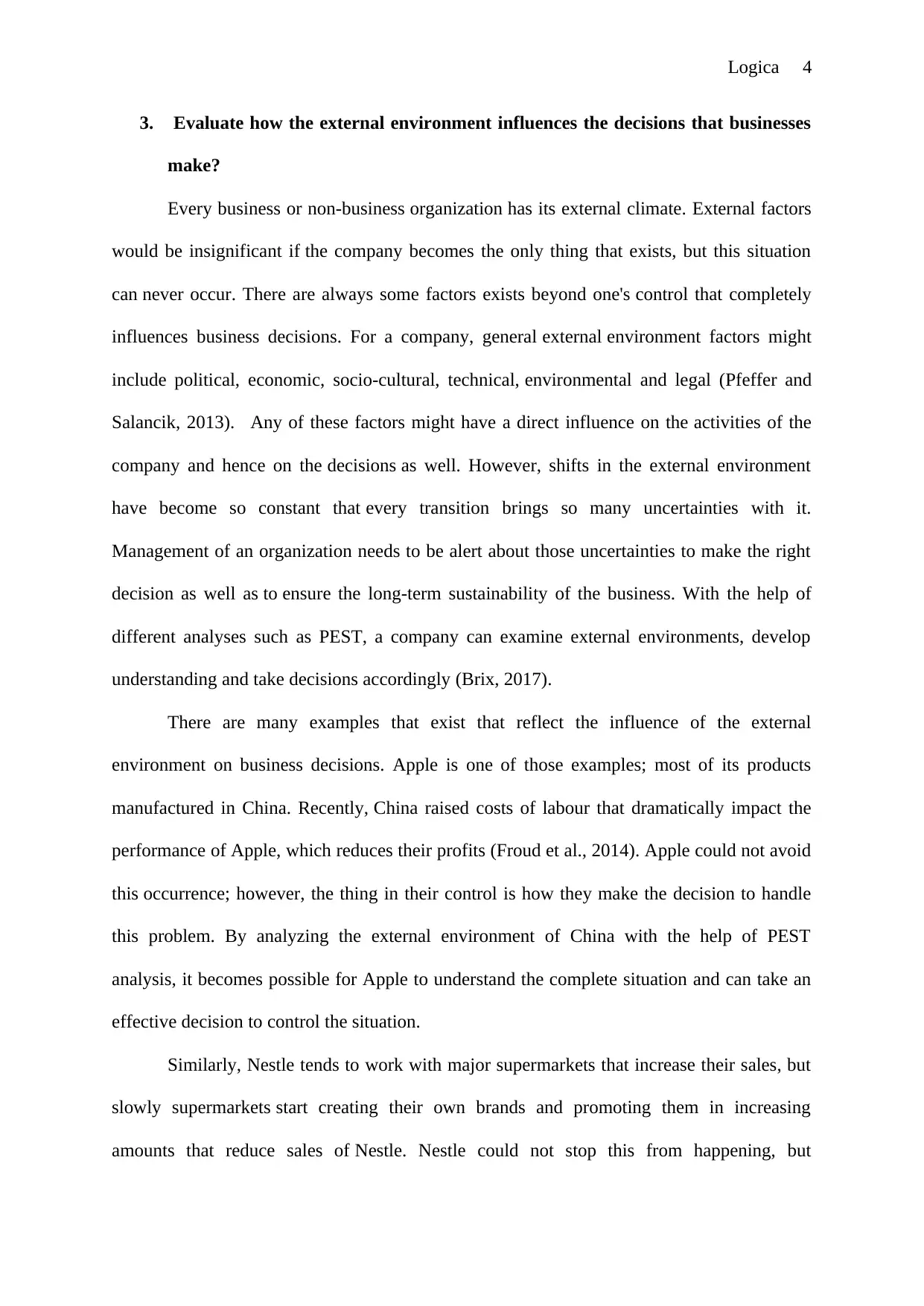
Logica 4
3. Evaluate how the external environment influences the decisions that businesses
make?
Every business or non-business organization has its external climate. External factors
would be insignificant if the company becomes the only thing that exists, but this situation
can never occur. There are always some factors exists beyond one's control that completely
influences business decisions. For a company, general external environment factors might
include political, economic, socio-cultural, technical, environmental and legal (Pfeffer and
Salancik, 2013). Any of these factors might have a direct influence on the activities of the
company and hence on the decisions as well. However, shifts in the external environment
have become so constant that every transition brings so many uncertainties with it.
Management of an organization needs to be alert about those uncertainties to make the right
decision as well as to ensure the long-term sustainability of the business. With the help of
different analyses such as PEST, a company can examine external environments, develop
understanding and take decisions accordingly (Brix, 2017).
There are many examples that exist that reflect the influence of the external
environment on business decisions. Apple is one of those examples; most of its products
manufactured in China. Recently, China raised costs of labour that dramatically impact the
performance of Apple, which reduces their profits (Froud et al., 2014). Apple could not avoid
this occurrence; however, the thing in their control is how they make the decision to handle
this problem. By analyzing the external environment of China with the help of PEST
analysis, it becomes possible for Apple to understand the complete situation and can take an
effective decision to control the situation.
Similarly, Nestle tends to work with major supermarkets that increase their sales, but
slowly supermarkets start creating their own brands and promoting them in increasing
amounts that reduce sales of Nestle. Nestle could not stop this from happening, but
3. Evaluate how the external environment influences the decisions that businesses
make?
Every business or non-business organization has its external climate. External factors
would be insignificant if the company becomes the only thing that exists, but this situation
can never occur. There are always some factors exists beyond one's control that completely
influences business decisions. For a company, general external environment factors might
include political, economic, socio-cultural, technical, environmental and legal (Pfeffer and
Salancik, 2013). Any of these factors might have a direct influence on the activities of the
company and hence on the decisions as well. However, shifts in the external environment
have become so constant that every transition brings so many uncertainties with it.
Management of an organization needs to be alert about those uncertainties to make the right
decision as well as to ensure the long-term sustainability of the business. With the help of
different analyses such as PEST, a company can examine external environments, develop
understanding and take decisions accordingly (Brix, 2017).
There are many examples that exist that reflect the influence of the external
environment on business decisions. Apple is one of those examples; most of its products
manufactured in China. Recently, China raised costs of labour that dramatically impact the
performance of Apple, which reduces their profits (Froud et al., 2014). Apple could not avoid
this occurrence; however, the thing in their control is how they make the decision to handle
this problem. By analyzing the external environment of China with the help of PEST
analysis, it becomes possible for Apple to understand the complete situation and can take an
effective decision to control the situation.
Similarly, Nestle tends to work with major supermarkets that increase their sales, but
slowly supermarkets start creating their own brands and promoting them in increasing
amounts that reduce sales of Nestle. Nestle could not stop this from happening, but
Paraphrase This Document
Need a fresh take? Get an instant paraphrase of this document with our AI Paraphraser
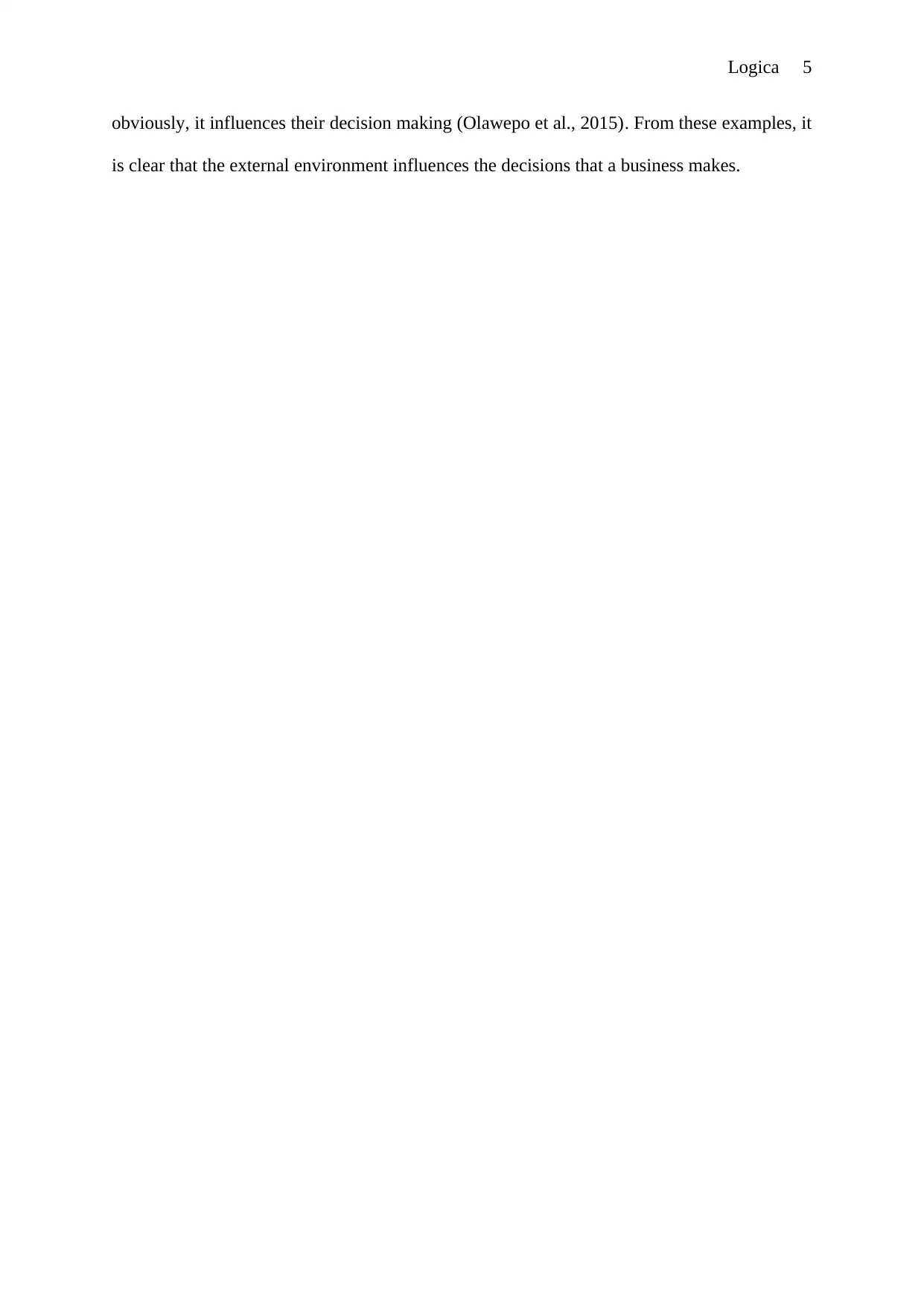
Logica 5
obviously, it influences their decision making (Olawepo et al., 2015). From these examples, it
is clear that the external environment influences the decisions that a business makes.
obviously, it influences their decision making (Olawepo et al., 2015). From these examples, it
is clear that the external environment influences the decisions that a business makes.
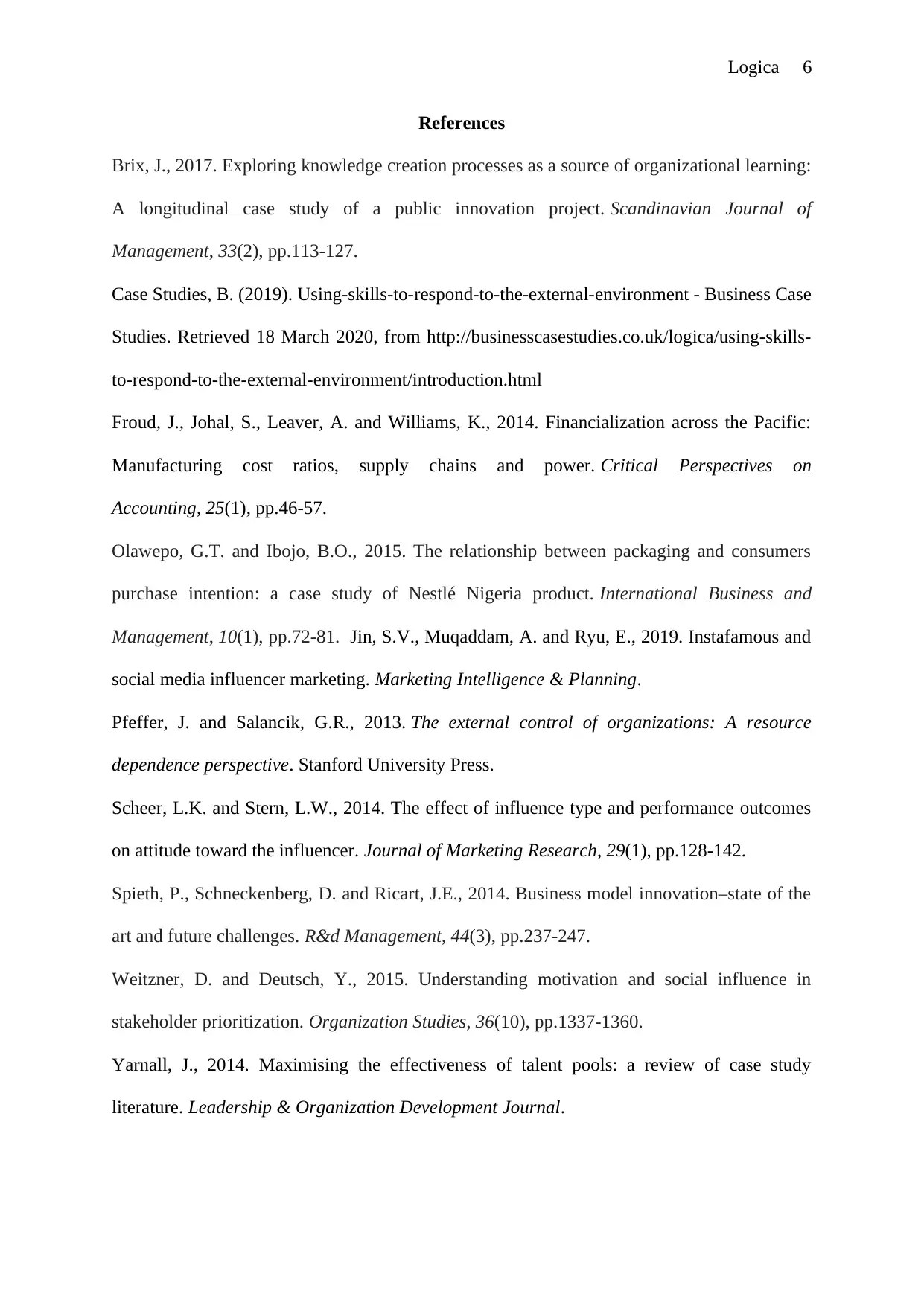
Logica 6
References
Brix, J., 2017. Exploring knowledge creation processes as a source of organizational learning:
A longitudinal case study of a public innovation project. Scandinavian Journal of
Management, 33(2), pp.113-127.
Case Studies, B. (2019). Using-skills-to-respond-to-the-external-environment - Business Case
Studies. Retrieved 18 March 2020, from http://businesscasestudies.co.uk/logica/using-skills-
to-respond-to-the-external-environment/introduction.html
Froud, J., Johal, S., Leaver, A. and Williams, K., 2014. Financialization across the Pacific:
Manufacturing cost ratios, supply chains and power. Critical Perspectives on
Accounting, 25(1), pp.46-57.
Olawepo, G.T. and Ibojo, B.O., 2015. The relationship between packaging and consumers
purchase intention: a case study of Nestlé Nigeria product. International Business and
Management, 10(1), pp.72-81. Jin, S.V., Muqaddam, A. and Ryu, E., 2019. Instafamous and
social media influencer marketing. Marketing Intelligence & Planning.
Pfeffer, J. and Salancik, G.R., 2013. The external control of organizations: A resource
dependence perspective. Stanford University Press.
Scheer, L.K. and Stern, L.W., 2014. The effect of influence type and performance outcomes
on attitude toward the influencer. Journal of Marketing Research, 29(1), pp.128-142.
Spieth, P., Schneckenberg, D. and Ricart, J.E., 2014. Business model innovation–state of the
art and future challenges. R&d Management, 44(3), pp.237-247.
Weitzner, D. and Deutsch, Y., 2015. Understanding motivation and social influence in
stakeholder prioritization. Organization Studies, 36(10), pp.1337-1360.
Yarnall, J., 2014. Maximising the effectiveness of talent pools: a review of case study
literature. Leadership & Organization Development Journal.
References
Brix, J., 2017. Exploring knowledge creation processes as a source of organizational learning:
A longitudinal case study of a public innovation project. Scandinavian Journal of
Management, 33(2), pp.113-127.
Case Studies, B. (2019). Using-skills-to-respond-to-the-external-environment - Business Case
Studies. Retrieved 18 March 2020, from http://businesscasestudies.co.uk/logica/using-skills-
to-respond-to-the-external-environment/introduction.html
Froud, J., Johal, S., Leaver, A. and Williams, K., 2014. Financialization across the Pacific:
Manufacturing cost ratios, supply chains and power. Critical Perspectives on
Accounting, 25(1), pp.46-57.
Olawepo, G.T. and Ibojo, B.O., 2015. The relationship between packaging and consumers
purchase intention: a case study of Nestlé Nigeria product. International Business and
Management, 10(1), pp.72-81. Jin, S.V., Muqaddam, A. and Ryu, E., 2019. Instafamous and
social media influencer marketing. Marketing Intelligence & Planning.
Pfeffer, J. and Salancik, G.R., 2013. The external control of organizations: A resource
dependence perspective. Stanford University Press.
Scheer, L.K. and Stern, L.W., 2014. The effect of influence type and performance outcomes
on attitude toward the influencer. Journal of Marketing Research, 29(1), pp.128-142.
Spieth, P., Schneckenberg, D. and Ricart, J.E., 2014. Business model innovation–state of the
art and future challenges. R&d Management, 44(3), pp.237-247.
Weitzner, D. and Deutsch, Y., 2015. Understanding motivation and social influence in
stakeholder prioritization. Organization Studies, 36(10), pp.1337-1360.
Yarnall, J., 2014. Maximising the effectiveness of talent pools: a review of case study
literature. Leadership & Organization Development Journal.
⊘ This is a preview!⊘
Do you want full access?
Subscribe today to unlock all pages.

Trusted by 1+ million students worldwide
1 out of 6
Related Documents
Your All-in-One AI-Powered Toolkit for Academic Success.
+13062052269
info@desklib.com
Available 24*7 on WhatsApp / Email
![[object Object]](/_next/static/media/star-bottom.7253800d.svg)
Unlock your academic potential
Copyright © 2020–2025 A2Z Services. All Rights Reserved. Developed and managed by ZUCOL.




